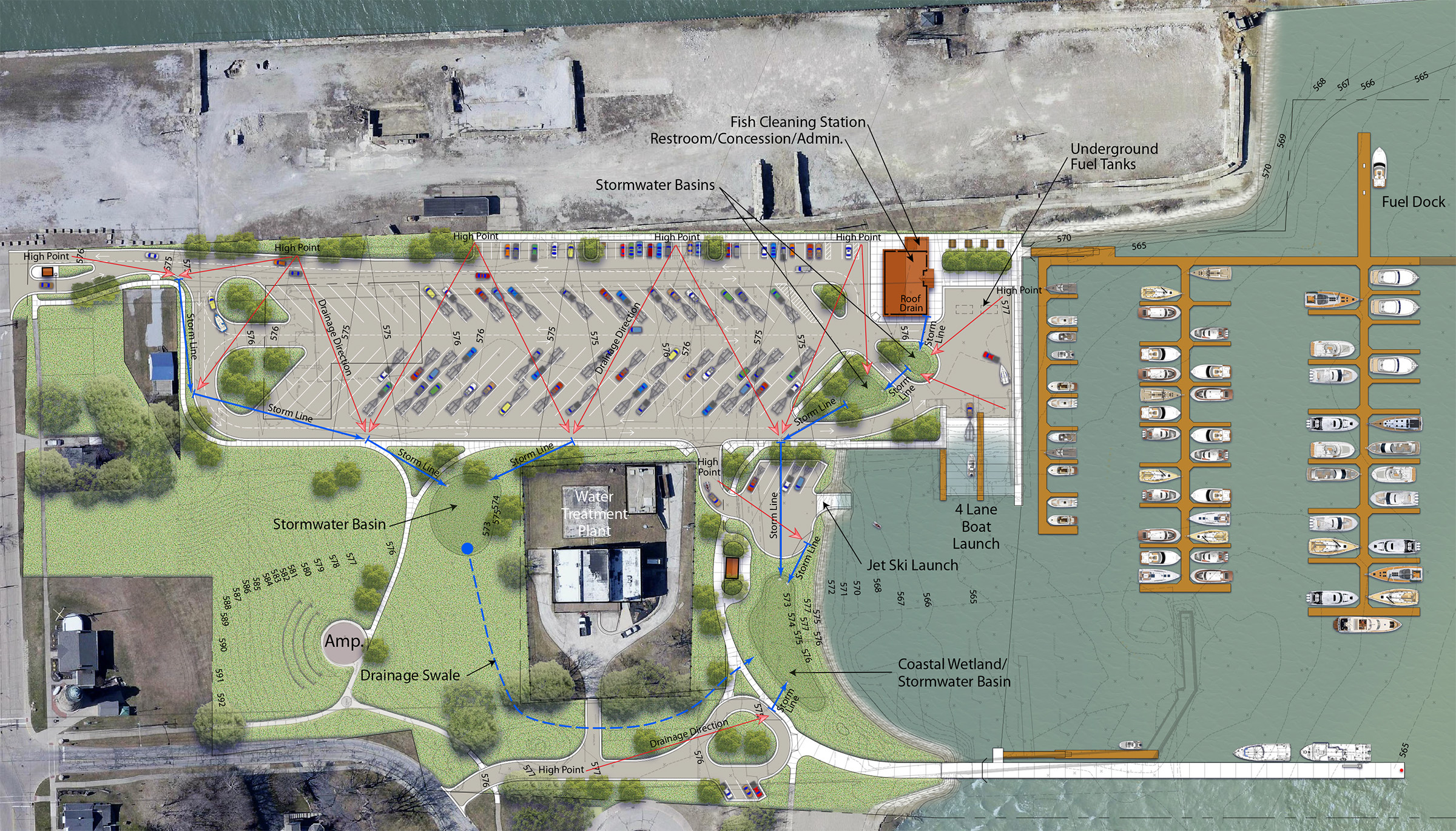
Stormwater Plans, Practices, and Payoffs
Published on April 26, 2022When we talk about stormwater management, most conversations begin with flood control and how to plan for and mitigate damage from design-basis rain events, and in the case of coastal marinas — storm surges. Without a doubt, public and private entities alike, including marinas, require some degree of flood or high-water measures in place to protect property, people, and operational performance.
However, there is an equally important benefit to implementing stormwater best management practices (BMPs): the protection of natural resources such as lakes, rivers, oceans, and the aquatic life within. Marinas and waterfront facilities play an instrumental role in protecting our nation’s water. And, they have a vested interest in doing so. Clean water not only supports recreational enjoyment. It supports profitable business.
The Culprit
The main issue at hand is water contamination by upland pollutants moving into the waterway. This is measured as total suspended solids (TSS). Total suspended solids are undissolved particles larger than 2 microns in size: sand, gravel, silt, clay, erosion materials, runoff, or man-made pollutants. Classified as a “conventional pollutant” by the U.S. Clean Water Act, TSS in large amounts can pose threats to the integrity of our water resources. High TSS levels can decrease water’s natural dissolved oxygen and increase water temperature, potentially rendering the water inhabitable. It can also affect the turbidity or cloudiness of water, thereby blocking sunlight, stunting photosynthesis, and decreasing the survival rate of aquatic life.
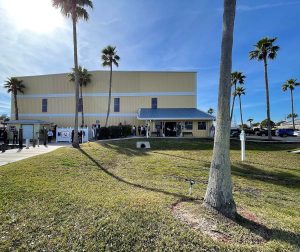
Rainwater collected at this Daytona Beach marina is filtered via interior stormwater systems before discharging through an outfall pipe into a shallow exterior detention basin.
TSS pollution happens everywhere, from naturally occurring runoff along rivers and lakes, to runoff from the impervious hardscape of a community such as buildings, roofs, roads, and parking lots. Streambank stabilization and erosion control techniques can help minimize runoff in our green spaces, but engineered solutions are generally needed to address TSS in urban or built environments — including marinas. In this case, solutions such as site grading, stormwater detention basins, forebays, or infrastructure upgrades may be required. Let’s explore the options.
Site Plans
An excellent first step in evaluating marina stormwater needs is by developing an existing site plan, including a topographic map. This document provides marina operators with a clear picture of how surface water flows throughout their property, where potential stormwater pollutants are located, where pollutants mix with stormwater, and where stormwater exits the property. A site plan should address five key areas:
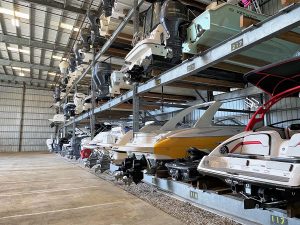
- The location of existing buildings and permanent structures
- All paved areas, including roads and access routes
- Stormwater drainage patterns, conveyances (storm sewers, surface drainage, rooftop drainage, swales, ditches, and forebays)
- All locations where source materials are used, stored or otherwise located at the marina
- All locations where industrial activity occurs (outdoor handling, treatment, storage or disposal, loading and unloading areas, outdoor cleaning activities that disturb the land surface, hazardous waste storage or disposal facilities)
Site Grading
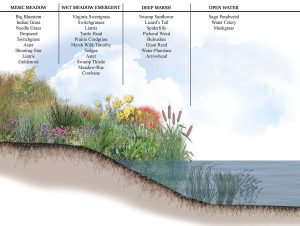
Following the existing conditions exercise, it is helpful to evaluate the overall grade or slope of a marina property. Does the site as a whole tilt toward or away from the waterfront? What about the parking lot? If the answers are “toward,” gravity is, unfortunately, funneling every particle of TSS directly into the water. In this instance, marina owners might consider working with a site engineer to reverse or modify the overall tilt of the landscape. If a complete site re-grade is not feasible, a creative approach to moving stormwater may be through “scissoring” the surface landscape to allow for more collection points and distribution to shallow trenches or swales. Open-air swales can assist in dispersing and filtering stormwater as it drains toward detention basins or forebays.
Forebays
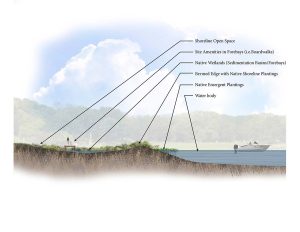
Forebays are small, engineered basins for collecting stormwater and a means to trap and filter sediment, debris, and runoff (TSS) before it enters a larger body of water. They function very much like rain gardens: living, growing, wetland-like features with native plants, whose deep roots absorb water and sediments — “cleaning” contaminants through a combination of microbial action in the soil, vegetative uptake, evaporation, and transpiration.
The most effective design is a series of forebays set to drain from one into another in sequence until ultimately discharging into the nearby river or lake. This chain approach yields a more comprehensive degree of filtration and removal of any potentially harmful pollutants to keep the river or lake clean. Forebays are constructed by excavating a basin or depression, lining the bottom with stone — and in some cases sand mix — and topping with soil and native wetland vegetation. These basins can also serve as attractive vegetated features improving site appearance and ambiance.
Dry Stack Storage
Sound stormwater practices at marinas also include removing as many maintenance activities from the outdoors as possible, and minimizing runoff from buildings and paved areas. Let’s look at storage facilities as an example. Many marinas have large dry stack storage buildings where customers’ boats are stored in the off season. Massive racks line the interior of the building, where vessels are winterized and protected from the elements until spring.
A marina in Daytona Beach, Florida, provides an excellent example of creative stormwater solutions within its dry stack storage facility. The marina worked with designers and engineers to construct indoor stormwater storage areas just beneath the racks of boats, and fill them with layers of four-inch-diameter stone. Rainwater collected from the roof of the building is funneled inside and into a series of downspouts, which deposit rainwater into the rock areas situated below the boats. With the sandy conditions found in mid-state Florida, this system allows rainwater to be filtered through the rock and underlying sand before exiting the facility through a perforated outfall pipe and into a detention basin, resulting in a creative and effective way to filter runoff and minimize TSS exposure to the Intracoastal Waterway.
Stormwater Aesthetics
Stormwater systems are also an opportunity to transform a utility into an amenity. Forebays and stormwater basins add a pleasing and colorful natural aesthetic to the marina environment and, unbeknownst to most, are protecting the watershed from pollution as well. Done right, stormwater basins look like artful additions to the marina landscape.
Stormwater practices can also be implemented in unsuspecting places, like marina parking lots. This is most easily done by adding forebays to islands within the parking lot area. These small basins look right at home among other landscaping or under trees, whose canopies offer the additional benefit of helping to reduce the heat island effect of large, paved spaces such as parking lots. It can be difficult for marina owners to forfeit parking spaces for this use, but the long-term benefits are multi-fold and the stormwater conveyance greatly improved.
There are other opportune places to boost aesthetics with the selection of native plants conducive to marine environments. Deep marsh plant varietals are excellent semi-submerged or at the water’s edge, while wet meadow emergent plants are a good choice for the bermed edges of detention basins or forebays. For lawns and upland areas, any number of native perennials or grasses selected for the right growing zone will lend flourishes of color, texture, and appeal year after year with very little ongoing maintenance.
Clean Marinas Programs
All of the aforementioned approaches are excellent first steps in managing marina stormwater. Those wishing to commit to broader-spectrum improvements and establish other long-term, sustainable marina practices should consider participating in their state’s Clean Marina program. In general, Clean Marina programs encourage environmental and managerial best practices beyond the scope of state regulations. The goal is to promote sound marina and boating practices to reduce pollution, enhance fish and wildlife habitat, and protect water quality.
No surprise, stormwater management is a key component of a Clean Marina program, and each state organization sets forth its own set of guidelines related to preventing or reducing water pollution through sound boat-keeping practices, education, signage, waste management, spill prevention, fuel management, and on-site runoff, to name a few.
There is no requirement to join these programs. However, meeting program standards has become an industry badge of honor— not to mention, a great marketing tool and means to secure funding.
Plans, Practices, and Payoffs
Stormwater management solutions may not be as flashy as other marina improvement projects. Many will go unnoticed entirely. But perhaps that’s the beauty of it all, knowing that systems are in place, cleverly conveying stormwater and pollutant runoff throughout the property in order to enhance the real star of the show — our recreational waters. As our natural resources become increasingly threatened and in higher demand, we must all do our due diligence to protect what remains and to set an example of environmental stewardship for the next generation of boaters and water enthusiasts. With the right plans and practices in place, we can do just that.
Dan Williams, PLA, ASLA, AHLP is senior landscape architect at MSA. He can be reached at dwilliams@msa-ps.com.
| Categories | |
| Tags |





